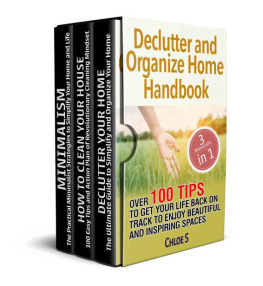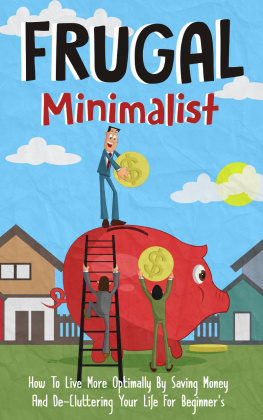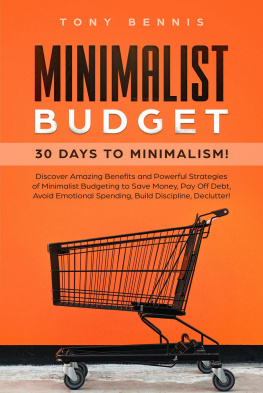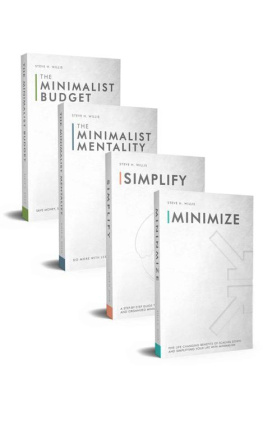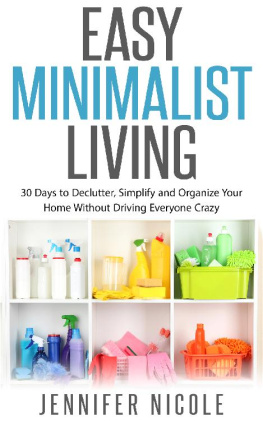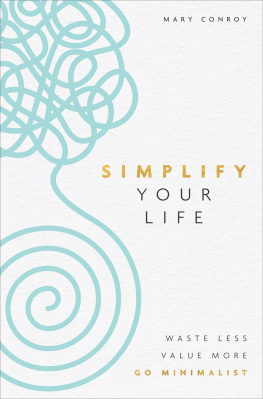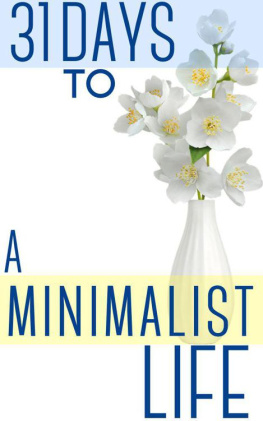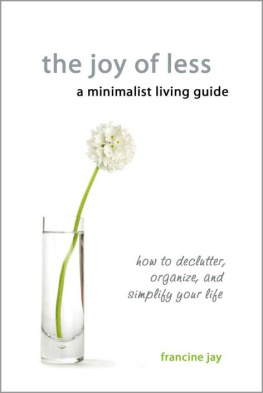Declutter and Organize Home Handbook
Over 100 Tips to Get Your Life Back on Track to Enjoy Beautiful and Inspiring Spaces
ChloeS
Copyright 2018 by Chloe S - All rights reserved.
This document is geared towards providing exact and reliable information in regard to the topic and issue covered. The publication is sold with the idea that the publisher is not required to render an accounting, officially permitted, or otherwise, qualified services. If advice is necessary, legal or professional, a practiced individual in the profession should be ordered.
- From a Declaration of Principles which was accepted and approved equally by a Committee of the American Bar Association and a Committee of Publishers and Associations.
In no way is it legal to reproduce, duplicate, or transmit any part of this document in either electronic means or in printed format. Recording of this publication is strictly prohibited and any storage of this document is not allowed unless with written permission from the publisher. All rights reserved.
The information provided herein is stated to be truthful and consistent, in that any liability, in terms of inattention or otherwise, by any usage or abuse of any policies, processes, or directions contained within is the solitary and utter responsibility of the recipient reader. Under no circumstances will any legal responsibility or blame be held against the publisher for any reparation, damages, or monetary loss due to the information herein, either directly or indirectly.
Respective authors own all copyrights not held by the publisher.
The information herein is offered for informational purposes solely and is universal as so. The presentation of the information is without a contract or any type of guarantee assurance.
The trademarks that are used are without any consent, and the publication of the trademark is without permission or backing by the trademark owner. All trademarks and brands within this book are for clarifying purposes only and are the owned by the owners themselves, not affiliated with this document.
Contents
Manuscript 1
Minimalism
The Practical Minimalist Strategies to Simplify Your Home and Life
Chloe S
Introduction
I want to thank you and congratulate you for purchasing the book, Minimalism: The Practical Minimalist Strategies to Simplify Your Home and Life .
This book contains proven steps and strategies on how to filter and shed the excess stuff and live your life with purpose. The philosophy of minimalism can be applied to any part of your life: what you own, what you do for work, what you put on your calendar, and how you relate to and connect with other people.
Minimalism is not about living in a tiny home and never owning more than 100 things (though you can certainly do that). To live as a minimalist does not mean you have to give up modern conveniences. There is one guiding principle for deciding what stays and what goes: figure out what brings value and purpose to your life and let go of the rest.
Applying this principle is not a one-size-fits-all approach. Each of usindividuals, couples, and familieswill use this policy for our particular season and situation. We will have different answers to the question of what brings value and purpose. You are reading this book because of your interest in minimalism. You also probably suspect that our cultures intense pursuit of having more and doing more doesnt lead to lasting happiness. Like me, you want to set about discovering how less means more in your life.
Minimalism helps you reassess your priorities so that you can identify and strip away the excess that doesnt line up with what you want. Although the journey often starts with removing physical clutter, it also leads you to let go of the clutter from your heart and soul. It brings awareness to the void in your life that youre trying to fill with things that will not fill it, at least not for very long.
Thanks again for purchasing this book, I hope you enjoy it!
Chapter 1:
An overview of minimalism
History of Minimalism
The minimalist movement was one that began in 1960's America in the art world in response to an art culture that had become cluttered and overblown. Minimalist artists of the time considered that the overuse of symbolism and metaphors in art had become excessive and reacted by creating a new form of art which focused on the materials of art, rather than the message.
For example, instead of painting canvases overloaded with hidden meanings and symbols, the minimalist might create a sculpture from a discarded piece of pottery or paint a portrait of a lone red square. The point was to make a return from the endless searching for meaning through motifs in art and instead embrace the simplicity of the essence of art; its materials and raw form.
The point was to create works with no concealed references to politics, history, current events or hot topics, but to create jobs which were beautiful in their simplicity simply.
Music followed suit. A 1964 composition by American composer Terry Riley named merely In C is widely considered the first arrangement of a minimalist music piece. As in the art world, music compositions had become overloaded with unnecessary instruments and layers, creating music that was ultimately unpleasant to listen to and an assault on the senses. The minimalist movement in music was a return to more straightforward harmonies with fewer instruments that allowed the listener to appreciate every note.
Fashion, too, embraced the movement. Minimalist fashion follows the same rules as in art and music; namely rejecting any design which is over-complicated or covered in any logos or images which refer to any subject and draw attention away from the everyday and straightforward form of the garment itself. Many people think of minimalist fashion to mean wearing nothing but all black or all white and having no accessories, but real minimalist style goes even further than this, with designs that may be very complex to tailor being considered minimalist because ultimately, when worn, they appear to have streamlined, simplistic forms.
Alternatively, minimalist fashion can seem bizarre as it may go so far as to even reject the form of the body itself and therefore garments can be deliberately designed to draw attention away from the figure of the wearer.
Of course, after the minimalist movement was adopted in the cultural spheres of art, music, and fashion, it was embraced by interior designers all over the world. Minimalism in interior design evolved a little later than minimalism for music, art, and fashion, but has become a favorite style across the globe.
The fundamental principle of minimalist interior design is less is more and has been influenced by styles from homes all over the world, especially from interior design styles in Japan. Minimalist homes are devoid of clutter and use color sparingly and in a block rather than using patterned wallpapers or murals, for example.
While interior design embraced minimalism in the twentieth-century, the architecture of buildings was becoming minimalist in design from as early as the 1920's. Minimalist structures often use geometric shapes such as domes and triangles in their design and materials such as glass and steel to prevent buildings from being over-stimulating to the eye.
In the modern world, minimalism can be seen in the designs of technological devices, such as streamlined laptops and TVs with no visible buttons or controls. Over the last century, minimalism has been adopted in some form in every visual culture.
However, the movement has grown from there, and there are people today who consider minimalism not to be merely an aesthetic ideology, but a way of life. The philosophy of a minimalist lifestyle is to live without all the non-essentials in life, such as excessive material belongings and flashy cars and homes.
Next page
